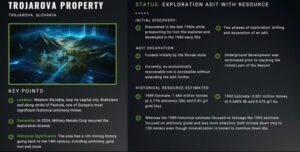The Antimony Dilemma: How Geopolitical Tensions are Reshaping Defense Supply Chains
The Pentagon is facing a critical juncture as its military stockpiles of essential armaments dwindle at an alarming rate, exacerbated by the ongoing war in Ukraine. Alarmingly, allies within Europe seem even worse off. Recent intelligence from Germany revealed a shocking statistic: the nation has only two days’ worth of ammunition left to counter potential military threats.
In response, the European Union made a significant move in March 2024, allocating €500 million under the Act in Support of Ammunition Production (ASAP). This initiative aims to ramp up production capacity to an ambitious target of 2 million shells annually by 2025. However, this surge in military requirements reveals a grave oversight—a reliance on a crucial metal called antimony, which the United States produces in negligible amounts.
The Rising Cost of Antimony
Recent developments have made the situation even direr. This summer, China imposed restrictions on antimony exports, resulting in a staggering 200% price increase over a few months. Antimony is essential not only for military applications but also for various technological and industrial uses. With the West in need of reliable antimony sources to bolster military production, the situation presents both a challenge and an opportunity for resourceful companies.
The Race for Antimony Production
Companies in Australia and Canada are stepping in to address this critical shortage. Take, for instance, Military Metals Corp. (CSE: MILI; OTCQB: MILIF), a Canadian exploration firm that has strategically positioned itself by acquiring valuable antimony assets in North America and Europe. Recognizing the impending crisis, Military Metals is on a mission to supply the Western world with antimony, aiming to decrease dependency on Chinese imports and enhance the region’s defense capabilities.
Historical context reveals that antimony played a pivotal role in securing Allied victories during WWII. Back then, control over critical minerals determined military power. Today, the roles have reversed, with China dominating the global antimony market, thrusting the West into a precarious position.
Expanding Resources in Slovakia and North America
Military Metals has recently announced significant acquisitions, including one of Europe’s largest antimony deposit sites in Slovakia. This historical site, which dates back to Soviet-era explorations, boasts a resource of over 60,998 tons of antimony—a staggering in-situ value of approximately $2 billion at current market prices. This could potentially transform Slovakia into a critical metals hub for Western defense industries.
Additionally, Military Metals has eyes on a historical antimony-gold play in Canada, once a major supplier to the Allies during WWI. Here, the historical drilling indicated grades of over 10.6 grams per ton gold and 3.4% antimony, presenting a profitable opportunity amidst skyrocketing prices.
Competitive Landscape and Investment Opportunities
While Military Metals continues to acquire these valuable assets, its valuation remains surprisingly low at around $25 million compared to peer companies like Perpetua Resources. Perpetua, with a slightly larger antimony resource of 90,000 tons, recently saw its market capitalization soar to approximately $700 million, attributed to rising investor interest amid geopolitical tensions.
As military demand for antimony surges, other players in the critical minerals space are also garnering attention:
- SQM (NYSE: SQM): A leader in lithium production, SQM is crucial in supplying lithium for military applications, especially for advanced systems like drones.
- Centrus Energy Corp. (NYSE: LEU): Plays a vital role in the nuclear fuel cycle, ensuring a reliable supply of low-enriched uranium for the U.S. Navy’s nuclear fleet.
- Barrick Gold Corporation (NYSE: GOLD) and Newmont Corporation (NYSE: NEM): Both companies not only excel in gold production but also play integral roles in copper mining—essential for defense applications.
A Call to Action
As the geopolitical landscape evolves, the imperative for robust domestic production of critical minerals like antimony has never been clearer. With Military Metals leading the charge and other companies exploring lucrative opportunities, the time for investors to explore these emerging dynamics is ripe.
In conclusion, while the current situation presents challenges—such as dependency on foreign suppliers and volatile prices—it simultaneously opens avenues for strategic investments in companies fortifying Western defense capabilities. As the demand for antimony and other critical minerals is poised to increase, aligning investments in these sectors could yield significant returns.
Stay informed and proactive in the evolving world of defense supply chains—explore the opportunities that await you.

